Editor's note
Since this guide was printed and last reviewed, a note alerting readers to the invasive nature of amur honeysuckle has been added to this page.
It has been estimated that many gardeners use about twice as much water in their landscapes as is needed. In most gardens, the amount of water used can be reduced without creating serious plant problems. In Missouri's climate, water-efficient gardening is an important approach to wise water use.
Water-efficient landscaping does not mean using only desert plants. In Missouri it means making an existing landscape or garden more water efficient or developing a new site with low water needs.
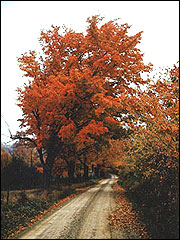 Gather ideas for plants to use in low water use zones by observing native plants along roadsides or other undisturbed areas.
Gather ideas for plants to use in low water use zones by observing native plants along roadsides or other undisturbed areas.
 Another native perennial flower that will prosper in low water use zones is purple coneflower (Echinacea purpurea).
Another native perennial flower that will prosper in low water use zones is purple coneflower (Echinacea purpurea).
Planning the garden and landscape
Homeowners have two options in developing a water-efficient garden and landscape:
- Plan an entirely new landscape
- Develop greater water efficiency in the existing landscape.
On large sites, both approaches may be possible as new sections are developed while older areas are remodeled.
The three zones
Water-efficient sites are organized around three major water-use areas. While three zones fit most situations, in some landscapes only one or two might be needed. The three zones are based on water needs throughout the year.
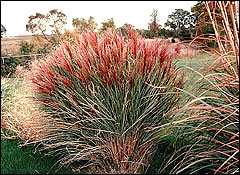 Many ornamental grasses make excellent choices as plants that will prosper in low water use zones.
Many ornamental grasses make excellent choices as plants that will prosper in low water use zones.
- Low water use zone
Plants do not receive additional watering except when they are becoming established. Once the turf or landscape plants are well rooted, natural rainfall is the only water source used, even during drought periods. - Moderate water use zone
Water is added during the period of establishment and at times of stress such as drought. Plants that develop special problems and need good care to regain vigor also may receive additional watering. Plants selected for this zone should have good drought tolerance, but they do not need as great a tolerance as plants selected for the low water use zone. - High water use zone
Water is supplied whenever the plants need it. In this zone, plants are selected for special needs or hobby interest. Therefore, these plants may not be able to survive even minimal drought stress without damage. High water use areas might be designed to keep an area visually very green or colorful and attractive at all times. Examples of high water use zones include highly visible landscaping near the entrance to the home, next to a heavily used patio area, or in a special area that may be viewed from indoors.
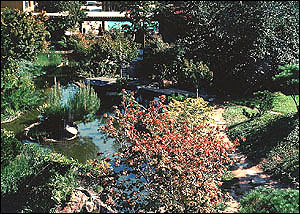 Complex landscapes with unusual plants often require larger areas to be designated as high water use zones.
Complex landscapes with unusual plants often require larger areas to be designated as high water use zones.
Established landscapes
Creating water use zones may be more difficult in existing landscapes where many different plants are already established. However, it may be possible to create a low water use zone in an existing landscape. As water availability is reduced, some plants may not survive and will need to be replaced by more durable types. In certain situations, a few especially valuable plants may be watered individually during stress periods while the rest of the area is not given any extra irrigation at any time.
Various means such as mulching, shade, efficient irrigation methods and hardscape surfaces can be used to make the established landscape, as well as a new landscape, more water efficient.
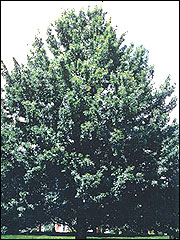 Oak trees are one of the best sources of shade whether for low, medium or high water use zones.
Oak trees are one of the best sources of shade whether for low, medium or high water use zones.
Plant selection
In planning new sites or adding new plants to existing sites, whenever possible you should choose plants for most of your landscape that can survive short periods of heat and drought.
Selecting plants for the high and medium water use zones is easy. Practically any plant that will survive Missouri's climate can be used in the high-use zone. In the medium-use area, most plants that form large, deep root systems can survive with watering only during stress periods.
Plants for the low water use area need more careful consideration. A good way to determine which plants can endure in the garden or landscape without extra water is to observe native plants. While we should not dig plants indiscriminately from native areas, the types of plants in these areas may well be the best indicators of what to use in a low maintenance landscape. Here are a few suggestions:
Shade trees
- Ash (green or white)
- Black cherry
- Black locust
- Honey locust (thornless)
- Kentucky coffee tree
- Mulberry (fruitless selections are available)
- Oaks (red, pin, shingle, post, chestnut)
- Osage orange (male selections will not produce fruits),
- River birch and sycamore are some native shade trees that can be useful selections for the low water use area of a landscape.
Small and flowering trees
- Amelanchier or serviceberry
- Black haw (Viburnum prunifolium)
- Buckeye
- Dogwood
- Golden rain tree
- Hawthorn
- Juniper
- Maple (amur or hedge)
- Redbud
- Pussy willow and witchhazel are small trees that might be used.
- Wahoo (Euonymus atropurpureus)
Shrubs
Not all shrubby plants suitable for the low water use area need to be natives. Among plants to consider are
- Honeysuckle
Fragrant honeysuckle and Tatarian honeysuckle grow well in Missouri. Amur honeysuckle, however, is highly invasive and should not be planted. For more information, see G6830, Selecting Landscape Plants: Deciduous Shrubs. - Juniper species
- Lilac
- Mock-orange
- Privet
- Pyracantha
- Many shrub roses, rose of sharon, sumac and arrowhead viburnum.
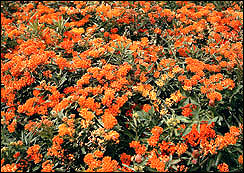 Butterfly weed (Asciepias tuberosa) is a native perennial flower that is excellent for low water use zones.
Butterfly weed (Asciepias tuberosa) is a native perennial flower that is excellent for low water use zones.
Perennial flowers
Some native flowers make an interesting addition to the low water use perennial flower border.
- Baptisia
- Black-eyed susan
- Butterfly weed
- Coreopsis
- Evening primrose
- Fall asters
- Gaillardia
- Goldenrod
- Liatris
- Prairie coneflower
- Purple coneflower
- Tall bellflower
- White snakeroot
- Yarrow
Do not consider these plants as the only ones that are suitable. You are sure to find others, both native and introduced, that have excellent low-maintenance potential. The plants listed are suggested only as a beginning in the selection process.
Soil improvement
The better and deeper the soil preparation and improvement, the greater will be the plant's ability to survive. Plants in soils that are shallow or rocky or have a hardpan where roots cannot penetrate will have poorer low-moisture endurance than those in deep, loose soils where roots can penetrate deeply and easily.
Since many landscapes have poor and shallow soils, soil improvement becomes important when establishing a low water requirement area. Dig or till the soil as deeply as possible before planting. If a hardpan exists that can be broken up, break it up. If you are planting trees, dig holes as wide as possible but no deeper than the tree's root ball. In clay soils, do not dig holes with smooth sides, since roots will circle the hole and fail to spread fully into the surrounding soil. Potted or balled trees or shrubs produced in very light or organic soils should have a transitional soil zone placed around them to aid establishment and stimulate thorough root expansion.
During the soil improvement process, have a soil test run to establish existing acidity or alkalinity as well as fertility levels. The soils should then be adjusted to be most suitable for the plants being added to the landscape. Adjusting pH, as well as improving fertility, may be necessary for establishing plants to ensure that they will survive under moisture stress.
Turf selection and maintenance
- Low water use zone
Once grass has been established in this zone, no additional irrigation is required. However, it might take one or two years to establish a mature lawn that can exist without irrigation. It will be necessary also to provide some irrigation during the lawn establishment period.Here is what to expect from your lawn in a low water requirement zone
- Turf browning during dry summer conditions, especially if there is no rainfall for 14 or more consecutive days.
- Summer dormancy if the drought continues. The entire lawn will turn a straw-tan color. Grass blades are usually dead during dormancy, but with adequate rainfall the lawn can still recover from stems, crowns and roots.
- Slower vertical growth that results in reduced mowing. Once grass has stopped growing, there is no need to continue mowing. In fact, mowing drought-stressed and dormant turf can sometimes cause wheel tracks that damage turf and remain visible for the entire summer.
- Severe loss of turf. Even though grasses are dormant, extended dry periods can cause large ground cracks, severe soil drying and excessive loss of turf cover, even when water is supplied later in the summer or early fall.
Here are some of the grasses that have been used successfully for low water use zones in Missouri landscapes
- Zoysiagrass
Once established, zoysiagrass provides an excellent summer turf that requires less mowing and watering. Since it is a warm-season grass, it has no water requirement during its winter dormancy period, October through April. It thrives during hot summers and will go dormant during dry summers long after the cool-season grasses, such as Kentucky bluegrass and tall fescue. Zoysiagrass is adapted to the entire state of Missouri. - Bermudagrass
This grass has the same low water requirements as zoysia, but is more susceptible to winter kill. Bermudagrass primarily is used south of I-70 in Missouri. Its tendency to spread aggressively is sometimes a drawback, especially in mulched areas. You should not plant bermudagrass into landscapes and neighborhoods where it is not already present. It works well as a roaming turf in large, nonirrigated parks or in physically isolated areas such as street medians. - Buffalograss
This warm-season grass is adapted throughout Missouri and is seldom killed by the lack of water or low temperatures. It has a slow vertical growth rate and will require mowing twice a month, or less, at a 2.5-inch height. In Missouri, the main problem with buffalograss is its tendency to become infested with weeds. You should personally observe the appearance and performance of buffalograss before it is added to a low water landscape theme. 'Sharps' and 'Texoka' are common types of seeded buffalograss. 'Prairie,' '609' and 'Mobuff' are vegetative types that have considerably improved turf appearance. - Tall fescue
This is a cool-season bunch grass with good drought tolerance, in part because of its deep root system. As dry conditions progress, tall fescue will remain green and actively growing longer than Kentucky bluegrass. 'K-31,' a common type of tall fescue, and several improved turf-type tall fescues have been used successfully in nonirrigated locations. Mowing turf as tall as possible, 3 inches or more, will help the grass survive dry conditions. - Kentucky bluegrass
This cool-season spreading grass has moderate drought tolerance. Kentucky bluegrass should not be used in the lower third of Missouri without irrigation. Mounded landscapes and south-facing slopes also are difficult growing conditions for Kentucky bluegrass. In a low water use zone, it should be mowed no lower than 3 inches. Common types of Kentucky bluegrass such as 'Argyle,' 'Kenblue' and 'Park' have been shown to have improved drought tolerance.
- Medium water use zone
This zone will receive occasional watering. Your goal should be to water deeply and infrequently. Water infrequently by allowing the lawn to undergo some moisture stress. As conditions become dry, the grass will wilt and turn a purple-blue color. In the next few days, the leaves will fold or roll and will have noticeably slowed growth. Applying 1.5 inches of water at this point should adequately wet the soil to about a foot in depth. To avoid runoff, you may need to use repeated watering cycles, i.e., apply half an inch of water each day for three days.
The amount of irrigation required for this zone will depend on local rainfall. Anticipate at least four deep and infrequent waterings (a total of 6 inches of irrigation) to maintain turf in a medium water use zone during the summer. Grasses suitable for a low water use zone can also be used in the medium water use zone. The extra water will produce a more attractive lawn and increase the cooling capacity of the turf within the landscape. In addition to the grasses mentioned above, many cultivars of turf-type tall fescue and Kentucky bluegrass have improved turf appearance and are suitable for the medium water use zone. - High water use zone
This zone will be watered at the first sign of turf wilting. The lawn will remain actively growing and undergo little moisture stress during the summer. This does not mean that the lawn should receive excessive irrigation. An inch of water each week, either from rainfall or irrigation, should be enough to maintain an attractive lawn in the high water use zone.
Zoysia and bermuda grasses do not have a high water requirement, but they can still be used in the high water use zone. Improved types of tall fescue, hard fescue, Kentucky bluegrasses and perennial ryegrass also may be used in this zone. Tall fescue should be used alone or in a mixture with 90 percent tall fescue and 10 percent Kentucky bluegrass. Kentucky bluegrass should be used alone or in various mixtures with perennial ryegrass and hard fescue.
Tips to save water in any lawn situation
- Select grasses that require less watering
In the medium and high water use zones, tall fescue will require 25 percent less water and zoysiagrass will require 50 percent less water than Kentucky bluegrass. Rankings of Missouri turfgrasses from most resistant to leaf wilting and browning during summer dry periods to least resistant are: buffalograss, bermuda, zoysia, tall fescue, Kentucky bluegrass, perennial ryegrass. - Develop a deep root system
Because deeper roots draw moisture from a larger volume of soil, they require less irrigation. Any grass management technique that produces deeper roots will improve lawn performance under dry conditions. - Mow tall and frequently
Taller grass has deeper roots and shades the soil surface. Mow frequently enough to avoid scalping; usually once a week is sufficient. Lawns that have been mowed too short will dry out and heat up quickly, develop shallow roots, and consequently decline rapidly in the summer. - Fertilize properly with nitrogen
In general, use 1 to 2 pounds nitrogen per 1,000 square feet per year on warm-season grasses such as zoysia, bermuda and buffalograss. Use 2 to 4 pounds of nitrogen per 1,000 square feet per year on cool-season grasses such as Kentucky bluegrass and tall fescue. Fertilize warm-season grasses from May through July and cool-season grasses primarily in the fall and occasionally in the spring.
Plant establishment
Thorough soil preparation and planting are essential to good plant establishment. However, once the plant is in place, several cultural conditions must be met before the plant will become well established. Most critical is watering during drought periods.
While the goal is to reach a point where no extra watering is needed, new plants with limited root systems need enough water to get established. This is most important in the first season after planting but can remain critical into the second and sometimes even the third year if weather conditions have been poor and root expansion is slow. Most of the frequent watering usually is needed the first season. During very dry, hot weather, one watering each week should be enough to prevent severe damage. Slow, thorough soaking of individual plants or plant beds is preferable to infrequent heavy watering or frequent light watering.
In situations with little water and high temperatures, one of the plant's first responses is for leaves to turn yellow and drop off. This may not happen with all plants, but as conditions become more severe, certain plants may develop leaf scorch. Scorch begins as yellowing and browning along the margins of leaves and may extend inward between the veins. Under severe conditions, some leaves may turn totally brown. If no watering has been done up to the time these symptoms develop, prompt action should be taken unless rains begin. If all leaves on a tree or shrub turn brown, there is little chance for survival.
To determine how well a tree or shrub has become established, closely examine a few new shoots that develop during the first flush of growth in the spring. The growth developed the year after a plant has been transplanted generally will be shorter than the growth of the previous year. As the plant becomes better established, the flush of new growth the next spring should increase in length. As the shoot length becomes more normal, it indicates that the plant has become established and additional watering can be discontinued.
Mulching
Mulching is very beneficial in all water-efficient landscape zones. It is essential where no additional watering is planned. Mulches conserve soil moisture by blocking evaporation. They also keep the soil cooler. Mulches have the added benefit of reducing weeds that will compete for moisture in the soil.
Many materials can be used for mulch. Organic materials generally are considered the best. They should be fairly fine textured and nonmatting. Straw, pine needles, bark nuggets, wood chips and other wood products are excellent materials for various effects in the landscape. Landscape fabrics or black plastic landscape mulch can be used beneath organic mulching materials to provide better weed control and to increase the mulch's ability to reduce water loss.
Rock mulches will control weeds and hold moisture when used in shady areas. In sunny spots, rocks tend to absorb and release heat over a longer period of time, which can increase water loss from nearby plant leaves.
Irrigation
Where irrigation is required, efficient water use is still extremely important. Efficient irrigation systems can save a lot of water. Soaker hoses or trickle or drip irrigation are the most water-efficient systems. Overhead sprinkling generally is less efficient than watering at the soil surface or within the soil. During hot weather, considerable water is lost to evaporation when overhead sprinkling is used.
It is relatively easy to determine how much water has been applied if you are using overhead sprinklers. Wide-mouthed cans or jars can be placed within the sprinkler area. The water collected in them can be measured to keep track of how much has been applied. During dry weather, usually about an inch of rainfall or irrigation water should be applied weekly. During very hot weather, watering may be increased to as much as 2 inches per week.
It is not as easy to determine how much water is being applied when soaker hoses or drip irrigation are used. There always will be more water in the soil closer to the hose or to each emitter than at distances farther away. Check a few spots in the irrigated area by carefully digging out soil with a trowel or spade. Ideally, you want to apply enough water to have the top 6 inches moist but not soggy wet a few hours after the irrigation system has been turned off. If water starts to run off before areas are thoroughly soaked, stop the sprinklers or hoses and do not start water again until the water has penetrated so the soil becomes more absorbent. Efficiency is lost rapidly when water runs off the surface.
Water will be absorbed with less evaporation if you irrigate during the cooler parts of the day. Early morning from 6 to 8 a.m. is ideal because leaves will dry quickly. Evening watering also is fairly efficient, but plants that are susceptible to leaf disease are more likely to be infected if leaves stay wet for too long. The least efficient watering time is during the heat of the day when evaporation is rapid.
Shade
Shade is another element that can be used to save water in the landscape. Where it can be used, shade reduces moisture loss by keeping surfaces cooler. Trees, shrubs and vines can all provide some benefit. Structures such as trellises and arbors also provide beneficial shade, although they do not produce as much cooling as shady plants.
Although trees and other plants lose moisture as they transpire, water released during transpiration cools the atmosphere and the soil. This reduces evaporation from other areas or from plants in their shade.
Some trees are more water efficient in sunny locations than others. A few of the most efficient types in sunny locations are ash, oak, hickory, red maple, sweetgum, pine and walnut. The less efficient trees are classified as understory trees. Understory trees need sun protection from other trees or structures. Trees that are not so efficient and are best as understory trees include beech, dogwood, hemlock, magnolia and redbud.
Shade is particularly useful in places where it keeps heat from building up near hard surfaces that not only become uncomfortably hot, but increase water loss from nearby plants and soil.
While shade is very useful for conserving moisture, not all plants can tolerate shade. Even beneath structures, water management is improved if mulch is used where dense shade might be too heavy for plant growth. Where adequate light exists in the landscape, shade-tolerant groundcovers or other plant materials can provide a similar but more attractive benefit.
Maintenance
Healthy plants are more drought tolerant than weak or damaged plants. In maintaining plants in water-efficient gardens and landscapes, watch out for disease or insect problems that may develop. Be careful to avoid mechanical damage such as bumping tree trunks with lawn mowers or damaging the bark with string trimmers.
Pruning plants can help by reducing the amount of foliage that is losing water. However, trimming should be done carefully. Severe pruning opens up the plant to more sunlight and, consequently, more water loss during midsummer.
Fertilization can be harmful during drought periods when watering cannot be done. If plants need nutrients, delay fertilization until fall or spring when weather conditions are more ideal and there is enough moisture in the soil for plants to easily absorb the nutrients.
In lawns, allow grass to get taller in nonirrigated areas during drought periods. Some grasses will go dormant, but others will benefit from the extra shade and extra photosynthesizing leaf area resulting from longer blades. During drought periods, raise the normal mowing height 25 to 50 percent.
Hard surfaces and heat barriers
There are many areas where hard surfacing cannot be avoided, such as a driveway, walk or patio. Shade is one of the ways to reduce heat buildup in these areas and, consequently, water loss around them. However, in some cases other options are available that have less tendency to build up heat and may also conserve moisture. Light-colored surfaces trap less heat than dark surfaces. Walks built with bark mulch or other organic materials, if practical, will be cooler than concrete or gravel.
Where hard surfaces must be used, a barrier of plants between them and the other surfaces can break the heat flow from one area to another. This may ease the stress on some plants, therefore reducing their water needs. Low fences with durable vines on them may provide such a barrier. Some heat-durable plants, such as junipers, can provide a heat barrier if used as a hedge. Around parking areas, taller plants or fences might be used. Durable vines on the fences along with heat-tolerant shrubs for dense hedges can all be beneficial for saving water and improving the survival of nearby plants.
Heat barriers also can be developed in other ways, depending on the home and the individual landscape. These barriers basically are means for controlling air movement in the landscape. Heat rising from hard-surfaced areas is directed away from plants that are not as heat tolerant as others might be. In addition to keeping hot air away from certain areas of the landscape, the same technique can help direct cool air beneath large trees or near patio areas to make them more comfortable as well as water efficient.